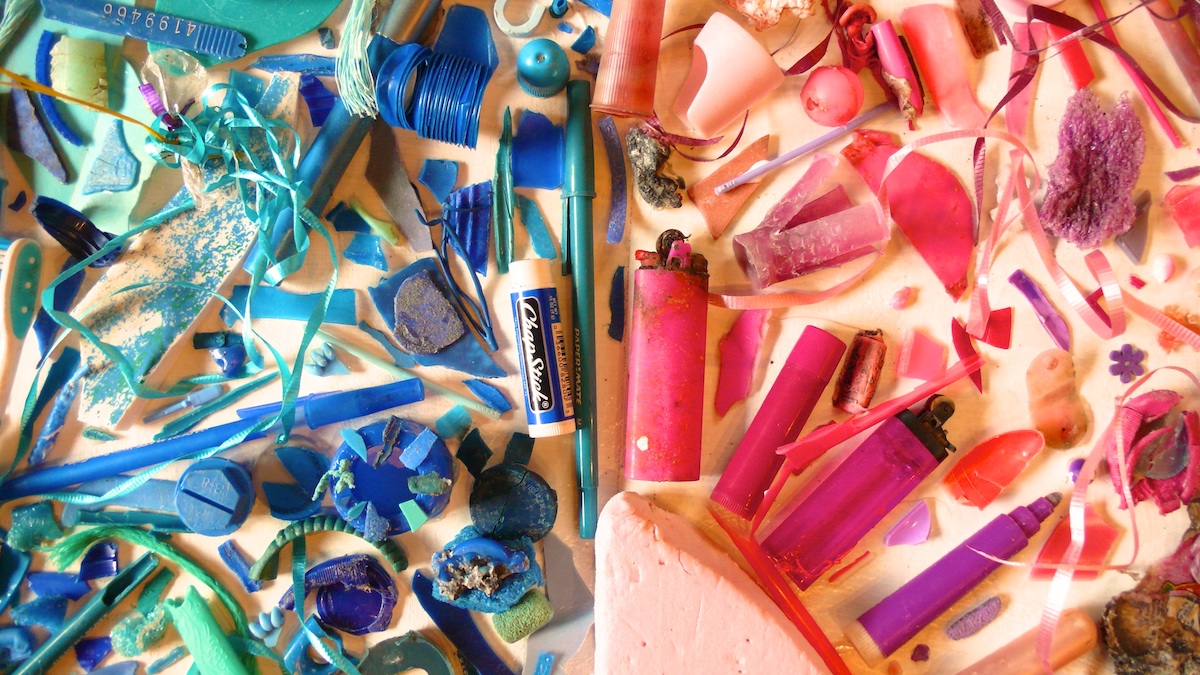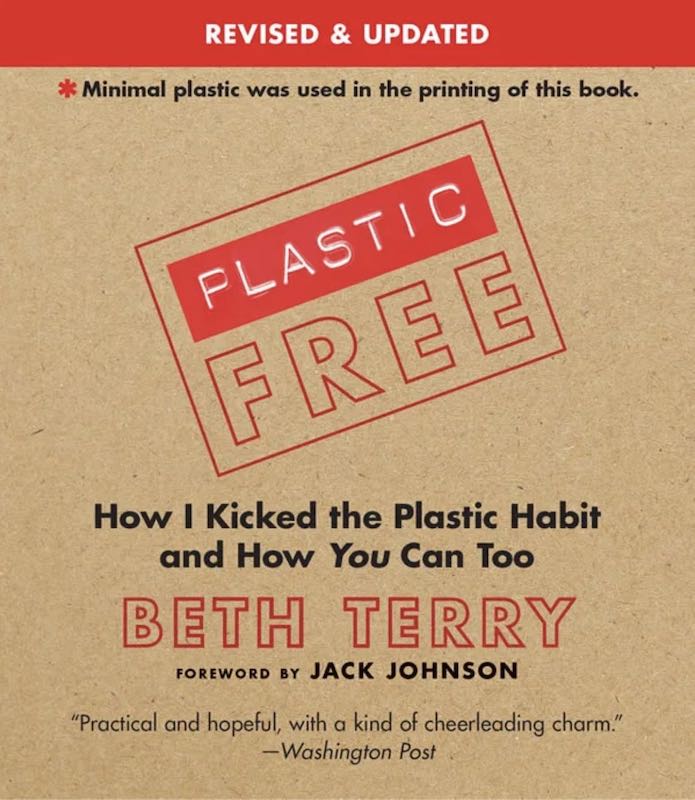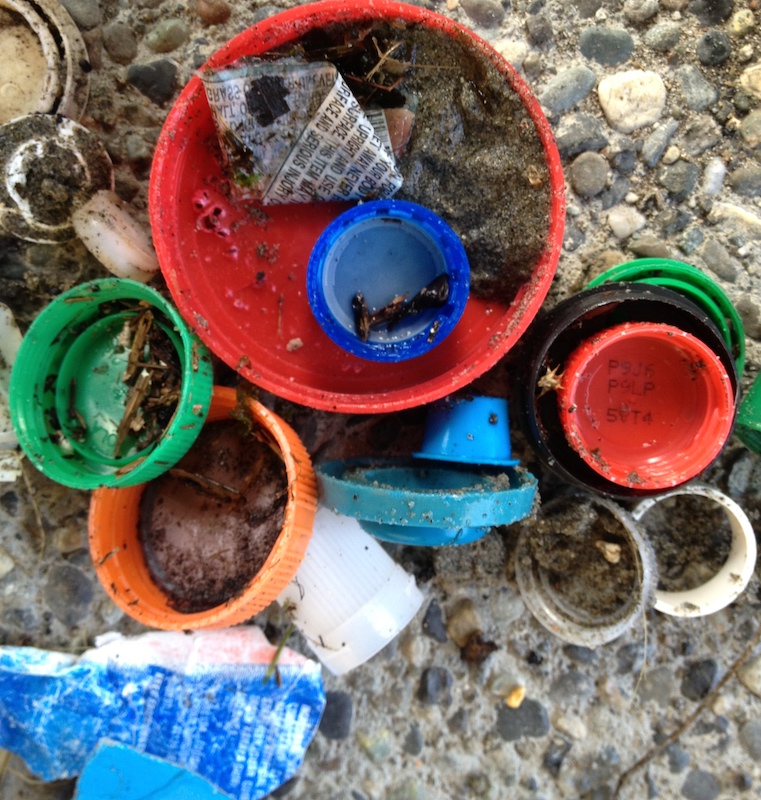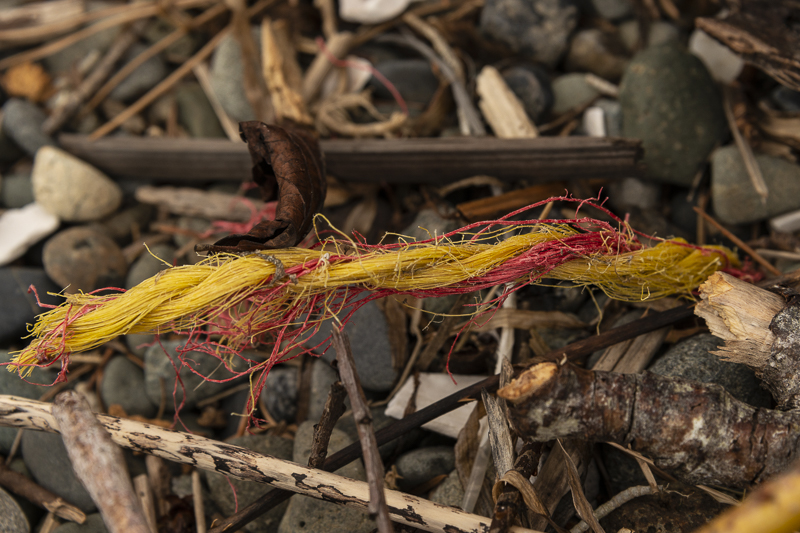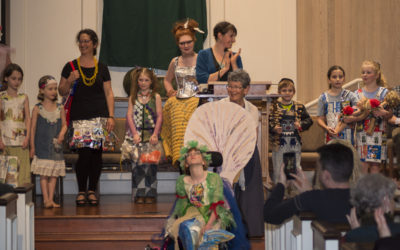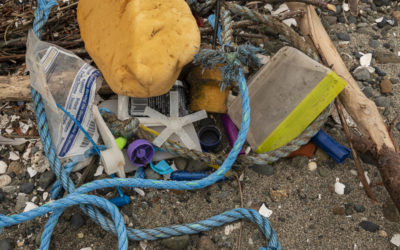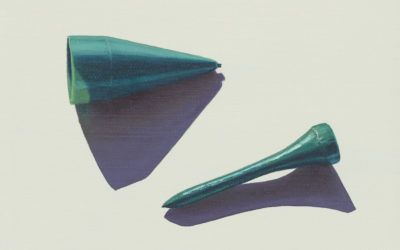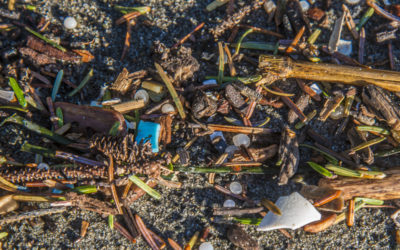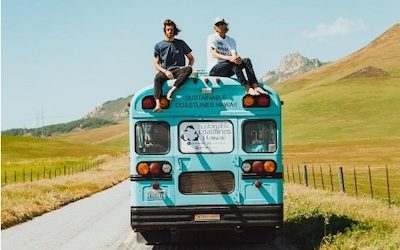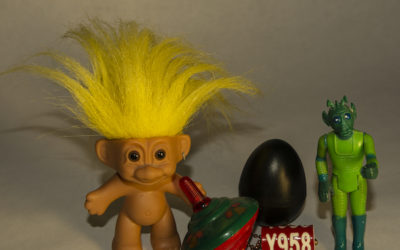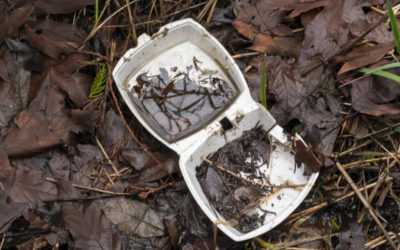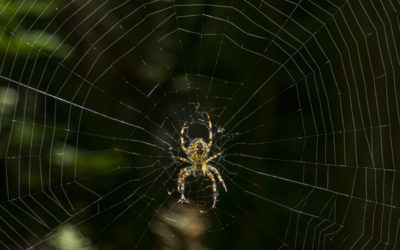THE KINGDOM OF PLASTICS
by Julie Jeanell Leung, Spring 2020
Photo of Schel Chelb estuary by John F. Williams
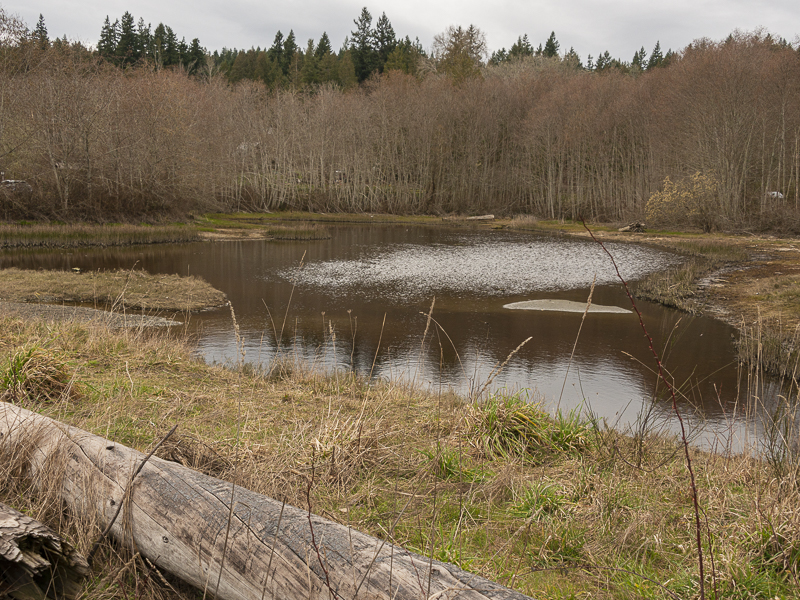
Photo of Schel Chelb estuary by John F. Williams
THE KINGDOM OF PLASTICS
by Julie Jeanell Leung, Spring 2020
Standing on the beach at the Schel Chelb Estuary, three days after the winter solstice in 2012, I saw the sky broken, the late sunrise cracking the clouds, the water below like battered metal reflecting light. Shorelines of Puget Sound appeared as ripped paper, black and gray silhouettes, layers of forested hills and mountain ranges, from Seattle and the Cascades in the east to Bremerton and the Olympics in the west. Sea lions barked in the distance and garbage trucks rattled around the south side of Bainbridge Island.
In this saltwater bay of Puget Sound, a mix of Pacific Ocean and freshwater rivers, extreme high tides occur during the winter months when the earth is at the perihelion, that is, closest to the sun and moon. These “king tides,” combined with low atmospheric pressure, had risen to a record 14.51 feet days earlier on December 17. As a volunteer beach naturalist, I had received an email asking me to make observations, so I had driven near these flooded edges of the island while my daughter took photos.
Parking at Schel Chelb on this December morning, I could see deposits of white Styrofoam thick near the road, markers from the king tides. On the sand I discovered more debris. Firework fragments lay scattered beside spirals of snail shells. Plastic bags rippled near jellyfish and seaweed. A deflated, yellow balloon contrasted against dark gravel. I picked up a red bottle cap and discovered a periwinkle snail living inside it. Higher on the beach, roses and grass grew among a pink tampon applicator, beer cans, and various pieces of plastic, some too similar to the trash in my own kitchen.
Within this natural sieve of logs and vegetation, I discovered a broken wing of a foam toy glider, the orange cone of a firework, pieces of duct tape, and faded red plastic tape with black lettering. Wearing boots, I stepped across a small stream, the freshwater outlet of the estuary, where Coho salmon returned in the fall, and where their young could hatch and swim to salt water through these bits of Styrofoam and remnants of the red tape warning “DANGER.” At home I had only grabbed one small grocery sack before driving out to the beach, and in fifteen minutes, walking less than a football field, I had stuffed it with garbage.
As a girl, each summer I walked on beaches and filled my pockets with polished shells and stones: presents the ocean left for me each morning. But as an adult, I was gathering pieces of trash. I tried to imagine the stories that brought the garbage into the water. Who needed the danger tape, yellow balloon, or plastic bags? On my porch at home, I dumped out the debris and counted the pieces, writing a list with each piece on it.
Collages created by the author’s fellow school families from found plastics. Photos by Rebecca Rockefeller
Trash had become more interesting than I had imagined, thanks to Liesl Clark and Rebecca Rockefeller, the parents of two families at my daughters’ school. For a project fair night, Liesl and Rebecca had collected and researched the plastic found on the shores of Bainbridge Island, presenting their results as mosaics. In my favorite piece, a blue river of pens, caps, and shards flowed through a landscape of white fireworks, Styrofoam, syringes, and bottles. Multicolored dots exploded across another canvas: dozens of plastic caps. I was shocked to learn that all these pieces had been collected on local shores. Our city had been one of the first in Washington State to ban plastic bags, but shoppers had brought their own sacks to the store years before the legislation. Residents walked or biked to the ferry, and many owned electric cars, constantly calculating carbon footprints. Bainbridge often appeared in postcards, representing a pristine and natural Northwest.
After showing interest in their projects, Rebecca invited me to meet her at the Schel-Chelb Estuary on the island’s south end. In the sand near the vegetation, we found white Styrofoam broken into tiny bits, mimicking fish eggs or shells. We removed plastic rope and caps. We discovered nurdles: pre-production resin pieces from factories that appear on beaches around the world. Rebecca handled them with gloves and stored these pellets in a glass jar. Nurdles can absorb toxic substances from seawater, concentrating PCBs and other hazardous chemicals that then enter the food web as fish consume them.
Later that spring, Rebecca, Liesl, and I designed a project for my oldest daughter’s middle school class. On a nearby beach, the seventh and eighth graders learned to observe and collect this garbage, marveling at the multiple pieces of trash in the sand. In classroom reflections, these students described the marine debris as “sad,” “gross,” and “frightening.”
This “sad,” “gross,” “frightening” debris once promised a new tomorrow, the reward for our victorious and scientific nation after World War II. In the 1945 short film, The Kingdom of Plastics, the narrator proclaimed “plastics take their rightful place in a world of peace.” The opening scene explained the title: Children played a game, guessing whether a hidden object was “animal, vegetable, or mineral.” A plastic thimble stumped them all before the father declared it must belong to “the fourth kingdom: the kingdom of plastics.” The film celebrated the future of “wondrously fine” wrinkle-free fabrics and “shoes more glamorous than Cinderella’s,” promising that plastic “will change the appearance of the everyday world.”
Plastics changed my 1970s childhood. I chewed on a blue plastic Bambi toy. My siblings and I played Twinkle, Twinkle, Little Star on a plastic keyboard and on a toy turntable with plastic records. In the kitchen, Mom mixed powdered milk in a purple Tupperware pitcher and we drank from plastic cups. Plastic toothbrushes cleaned our teeth. Adulthood demanded more plastic privileges and necessities. Razors. Tampons. Nail polish. Nylons. Contacts. Birth control pills. As I worked on this project with my daughter, my dependence on disposable plastics was evident. How would I live or be alive without plastic?
In her book Plastic Free: How I Kicked the Plastic Habit and You Can Too, Beth Terry, an activist who has reduced her own plastic use since 2007, stated that the average individual disposed of 88 to 120 pounds of plastic each year. Inspired by my experiences working on the project, I decided to keep track of our plastic waste in our home for ten days in December 2012. On the smallest day, I counted the plastic milk bottle lid and a brown sugar bag for a total of 0.2 ounce. On the largest day, I counted a shampoo bottle, a bottle of contact solution, wrapping from toilet paper, plastic from a bag of candy, a bag of brownie mix, a juice bottle, a hot dog bag, a plastic bag someone gave us, and plastic from a package of chicken, resulting in a total of more than 10 ounces. In ten days, we averaged around a quarter of a pound per day. In one year, our family could generate nearly 90 pounds of plastic waste.
In the days when I tracked our garbage, I developed headaches. My neck and back muscles tensed. I constantly discovered more unexpected plastic: a ring on the rice milk box, plastic on the frozen juice can, and wrapping on the organic bananas. On the beach when I twisted and stretched to examine details in tide pools, I felt exhilarated. But after turning and twisting to see plastic in my kitchen, I felt exhausted.
Grocery shopping had become a constant series of challenges to navigate, an intricate roller coaster of compromises. Wax paper replaced plastic bags in lunches, and each member of our family carried a stainless-steel water bottle. But I often had to decide whether packaging, product, or price was my priority. For example, in the produce aisle, I chose the only mandarin oranges that were not in a plastic container, but they often cost one dollar more per pound and were not organic. When I needed V8 juice for a recipe, I decided that cans were a better choice than a polymer bottle, but at home I realized that the six-pack had been wrapped in plastic. Despite my desire and care, plastic had continued to come home with me from the grocery store after every shopping trip.
In her book, Beth Terry shared recipes for homemade ketchup and complexion powders to help readers avoid purchasing plastic. She suggested sending produce stickers to mosaic artists so that even the tiny labels on fruit could be recycled. While I admired her devotion, I didn’t have time to mix my own condiments or complexion powder, or mail envelopes of produce stickers.
Examining my trash, I again observed my dependence on plastic, evidence of my own character. I had been impulsive. I had wanted orange juice and chocolate and prepared hummus. Contact lenses and tinted moisturizer documented my vanity. I had wanted comfort and convenience. I had wanted to buy appearance, ease, and time.
Plastic had become currency. I had traded pieces of my days for plastic that broke into tiny pieces. When I wanted a quick supper, I bought hot dogs and fries. I purchased a chicken from the deli in a plastic clamshell. I bought a few minutes for myself in exchange for plastic that would pollute the planet for centuries.
Nearly every piece of plastic that has been made still exists: an approximate total of six billion tons. Plastic has not biodegraded or disappeared. Instead sunlight or wave action has often broken it into smaller pieces that easily enter the food web. Captain Charles Moore, who first noticed the garbage gyres in the Pacific Ocean, has speculated that marine plastics not only have strangled and starved sea creatures, but could also poison animals by spreading toxic algae. He has estimated that it would require 1,000 boats working 79 years for 24 hours a day to remove only the surface debris in the seas.
Recycling has not been an effective solution. Only five to ten percent of plastics have been completely recycled. Metals and glass have been the easiest to recycle and reuse. But placing a plastic item in a bin has not guaranteed recycling. “Much of recycling is an elaborate charade,” wrote Charles Moore in his 2011 book, Plastic Ocean: How a Sea Captain’s Chance Discovery Launched a Determined Quest To Save the Oceans. Recyclables have often been sold to China, sent to the landfill, or incinerated. More than 10 million pounds a day have left the US for recycling in other nations, some spilling into the seas along the journey. Moreover, many trash items are not recyclable. Walking to the beach on that December morning in 2012, I noticed two recycle bins open, awaiting pick up, but the ubiquitous clamshells and packaging materials did not meet our city’s recycling requirements.
Through our actions, our emphasis on ease, and our misplaced priorities, we have revealed our belief that this planet is a receptacle for our waste. We have also discarded the health and lives of other creatures on this world, not to mention the lives yet to be born.
Microplastics and plastic fibers have been found in drinking water, in beer, and even inside lanternfish. A Canadian fisherman discovered chunks of garbage ripping through the digestive tract of a steelhead trout. Jellyfish have incorporated debris, their transparent bodies pulsing with garbage. When seabirds have died, piles of plastic remained after bones and feathers had decayed, marking their graves. Toxic chemicals from plastics have entered into our cells, measured even in breast milk. The Kingdom of Animals and the Kingdom of Plastics are merging.
And yet at times I confess I don’t care. I forget or rather, I don’t want to remember. In the stores, I purchase items without considering the waste: brownies that don’t need to be baked, yogurt cups that will be easy to eat. Online I buy products that arrive nested in bubble wrap packaging that ends up in my trashcan. I can’t think beyond the limits of my life or my family in order to make different choices. And sometimes I have few choices to make. Yet in a rush to save my own time, I’ve shortened the time of other lives. I have chosen to ignore my own choices. Consuming involves buying into this fantasy and forgetting the limits of our planet, a self-centered view evident in this modern age. We must return to a view of life that values sustaining relationships with the objects we own and sustaining relationships with the environment and its creatures, both present and future, within this world that we have polluted.
From the estuary that December morning, I brought home about 90 pieces of marine debris.
Beer cans (4)
Yellow balloon and ribbon
Styrofoam chunks
Blue plastic bucket remnant
Red “DANGER” ribbon (2 pieces, 3 feet total).
Purple glow stick
Plastic bags (9)
Green plastic soda bottle with yellow cap
Plastic liquor bottle
Rope (2 pieces)
Foam glider wing
Firework remnants (11)
Food wrappers (9)
Red plastic cigarette lighter
Styrofoam cup
Duct tape (6 inches)
Plastic nozzle from yellow mustard bottle
Energy drink can
White tape
Red plastic netting
Priority Mail envelope (sea grass growing through holes)
Transparent plastic food container
Piece of PVC pipe
Mayonnaise packet
Blue plastic pen cap
Green plastic plant saucer
Plastic caps and lids (16)
Miscellaneous plastic pieces (10)
Coffee cup lid
Pink plastic tampon applicator
Red plastic shard
The cans and bottles I placed in recycling, but the glow stick, shards, and other random items could only go in the trash. I carried the pieces into the cans and swept sand from the porch.
As I warmed my hands in the kitchen, my youngest daughter, Elisabeth, ten years old, rolled cookie dough, cutting out stars, trees, and moons. She sang a song about a wonderful world.
Polluted world. Wonderful world. Washing my hands, listening to my daughter’s song, I knew I must live in the duality, the ambiguity, this multicolored truth. The terror and beauty of Earth. The benefits and toxicities of plastics. The mix and mess of humanity, a mess that also exists inside me. I must teach my children to look beyond appearances, into the depths, past the postcard prettiness into the tiny details. I must teach them to consider how actions reflect and spread like the sunrise, even when choosing a drink of water.
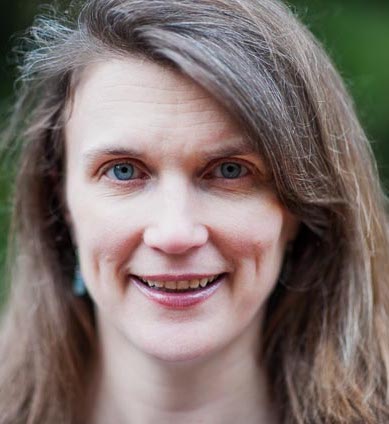
Julie Jeanell Leung received her MFA from the Rainier Writing Workshop at Pacific Lutheran University. Her creative nonfiction has appeared in a number of publications, including Bellingham Review, Blue Lyra Review, and Grist: The Journal for Writers. Her essays have been selected as a Finalist for Best of the Net and as a winner of the Living Earth Nonfiction Prize. Currently, she works as an Academic Instructor at Western Washington University’s SEA Discovery Center, teaching marine science. She is also the General Manager for Wild Society, a wilderness education nonprofit, connecting human hearts with the natural world. A beach naturalist and citizen scientist, Julie lives with her family on Bainbridge Island where she counts sea stars on the rocky shores.
Table of Contents, Issue #7, Spring 2020
Prêt-à-Porter Plastics
by Deb Rudnick, Spring 2020 Photos by John F. Williams except as notedby Deb Rudnick, Spring 2020 Photos by John F. Williams except as noted A bubble wrap bridal gown. Patio umbrella fabric cargo pants. A dress of VHS tape and electric cords. A grocery bag tutu....
Plastics & Our Salish Sea
by Alison Ahlgrim, Spring 2020Photo by John F. WilliamsPhoto by John F. Williamsby Alison Ahlgrim, Spring 2020 Take a walk along a beach anywhere along the Salish Sea, and you are likely to see all kinds of plastic waste – bottle caps, bags, toys, Styrofoam, bottles,...
Art and Plastics
by Karen Hackenberg, Spring 2020Painting by Karen HackenbergPainting by Karen Hackenbergby Karen Hackenberg, Spring 2020 Between Scylla and Charybdis, oil on linen, 28"x35", 2019, by Karen Hackenberg.My painting Between Scylla and Charybdis, can be seen as a metaphor...
Microplastics
by Julie Masura, Spring 2020Photo by Julie MasuraPhoto by Julie Masuraby Julie Masura, Spring 2020 “What do you know about plastics?" "Absolutely nothing.” This was the beginning of microplastics research at the University of Washington Tacoma’s Center for Urban...
Schroadtrip
"SCHROADTRIP": A PARLEY FOR THE OCEANS INITIATIVEby Nick Schippers (with Hans Schippers), Spring 2020 Growing up surfing on Washington’s remote and rugged coastlines, my brothers and I learned early on just how important our waters are. As avid surfers and watermen,...
Poetry-7
Poetry Spring 2020A Plastic Future Is Not Fantastic by Mahathi Mangipudi Photo by John F. WilliamsSmall Things by Janet Knox We gift them tiny plastic things to sit on a shelf or play and break to signify like or caring or thinking of you then toss in landfills...
Addressing the Plastic Problem
by Heather Trim, Spring 2020Photo by John F. WilliamsPhoto by John F. Williamsby Heather Trim, Spring 2020 Plastic waste is an issue for Washingtonians because we are a coastal state, and we have remaining endangered species who are potentially being impacted by...
A New Hope for Plastics
by Adelia Ritchie, Spring 2020Photo by John F. WilliamsPhoto by John F, Williamsby Adelia Ritchie, Spring 2020 If you’ve ever had to clear out those pesky cobwebs from every corner of your house, you know how ubiquitous and stubbornly persistent our house spiders can...
PLEASE HELP SUPPORT
SALISH MAGAZINE
DONATE
Salish Magazine contains no advertising and is free. Your donation is one big way you can help us inspire people with stories about things that they can see outdoors in our Salish Sea region.
We also don't advertise Salish Magazine, so please spread the word of this online resource to your friends and colleagues.
Thanks so much for your interest and your support.
We also don't advertise Salish Magazine, so please spread the word of this online resource to your friends and colleagues.
Thanks so much for your interest and your support.


